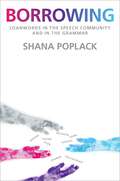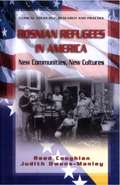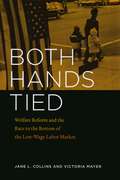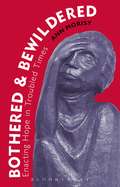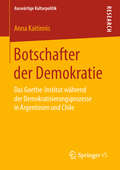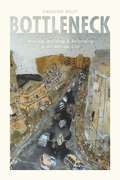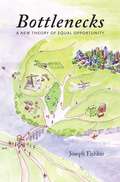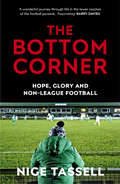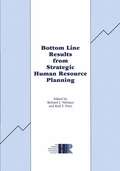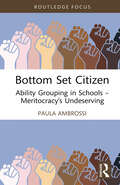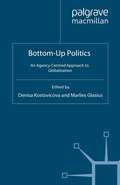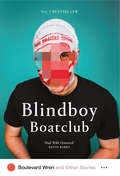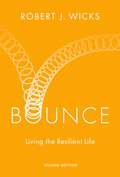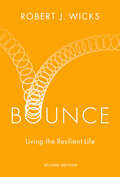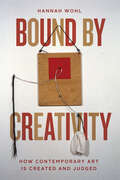- Table View
- List View
Borrowing: Loanwords in the Speech Community and in the Grammar
by Shana PoplackStudies of bilingual behavior have been proliferating for decades, yet short shrift has been given to its major manifestation, the incorporation of words from one language into the discourse of another. This volume redresses that imbalance by going straight to the source: bilingual speakers in their social context. Building on more than three decades of original research based on vast quantities of spontaneous performance data and a highly ramified analytical apparatus, Shana Poplack characterizes the phenomenon of lexical borrowing in the speech community and in the grammar, both synchronically and diachronically. In contrast to most other treatments, which deal with the product of borrowing (if they consider it at all), this book examines the process: how speakers go about incorporating foreign items into their bilingual discourse; how they adapt them to recipient-language grammatical structure; how these forms diffuse across speakers and communities; how long they persist in real time; and whether they change over the duration. Attacking some of the most contentious issue in language mixing research empirically, it tests hypotheses about established loanwords, nonce borrowings and code-switches on a wealth of unique datasets on typologically similar and distinct language pairs. A major focus is the detailed analysis of integration: the principal mechanism underlying the borrowing process. Though the shape the borrowed form assumes may be colored by community convention, Poplack shows that the act of transforming donor-language elements into native material is universal. Emphasis on actual speaker behavior coupled with strong standards of proof, including data-driven reports of rates of occurrence, conditioning of variant choice and measures of statistical significance, make Borrowing an indispensable reference on language contact and bilingual behavior.
BORROWING C: Loanwords in the Speech Community and in the Grammar
by Shana PoplackStudies of bilingual behavior have been proliferating for decades, yet short shrift has been given to its major manifestation, the incorporation of words from one language into the discourse of another. This volume redresses that imbalance by going straight to the source: bilingual speakers in their social context. Building on more than three decades of original research based on vast quantities of spontaneous performance data and a highly ramified analytical apparatus, Shana Poplack characterizes the phenomenon of lexical borrowing in the speech community and in the grammar, both synchronically and diachronically. In contrast to most other treatments, which deal with the product of borrowing (if they consider it at all), this book examines the process: how speakers go about incorporating foreign items into their bilingual discourse; how they adapt them to recipient-language grammatical structure; how these forms diffuse across speakers and communities; how long they persist in real time; and whether they change over the duration. Attacking some of the most contentious issue in language mixing research empirically, it tests hypotheses about established loanwords, nonce borrowings and code-switches on a wealth of unique datasets on typologically similar and distinct language pairs. A major focus is the detailed analysis of integration: the principal mechanism underlying the borrowing process. Though the shape the borrowed form assumes may be colored by community convention, Poplack shows that the act of transforming donor-language elements into native material is universal. Emphasis on actual speaker behavior coupled with strong standards of proof, including data-driven reports of rates of occurrence, conditioning of variant choice and measures of statistical significance, make Borrowing an indispensable reference on language contact and bilingual behavior.
Bosnian Refugees in America: New Communities, New Cultures (Clinical Sociology: Research and Practice)
by Reed Coughlan Judith Owens-ManleyIn April of 1992, war began in Bosnia. Sarajevo, site of the 1984 Winter Olympics, and, we were told, one of the most beautiful cities in the world, became a city under siege. For all of the people of Bosnia, life shifted in unimaginable ways in a matter of hours, days, or weeks. An immediate exodus began from Bosnia, and people who had never anticipated leaving their country became refugees, dependent upon a world system of resettlement for displaced persons. This book relates the experiences of a hundred Bosnian families who came to Utica, a town in upstate New York. Bosnians in Utica came here as refugees - ginning in 1993, having ?ed from the wars of succession in the former Yugoslavia. Our study evolved over several years as a result of our interests in the war in Bosnia and the massive ?ow of refugees that it precipitated. We began work on the project in the late 1990s as we set out to learn about the war and to explore refugee experiences of displacement, transit, and resettlement. Our intent is to portray the experience of Bosnian refugees in one American city and to capture, in their words, in as much detail as possible their adjustment to a new community and a new culture.
Both Hands Tied: Welfare Reform and the Race to the Bottom in the Low-Wage Labor Market
by Jane L. Collins Victoria MayerBoth Hands Tied studies the working poor in the United States, focusing in particular on the relation between welfare and low-wage earnings among working mothers. Grounded in the experience of thirty-three women living in Milwaukee and Racine, Wisconsin, it tells the story of their struggle to balance child care and wage-earning in poorly paying and often state-funded jobs with inflexible schedules—and the moments when these jobs failed them and they turned to the state for additional aid. Jane L. Collins and Victoria Mayer here examine the situations of these women in light of the 1996 national Personal Responsibility and Work Opportunity Reconciliation Act and other like-minded reforms—laws that ended the entitlement to welfare for those in need and provided an incentive for them to return to work. Arguing that this reform came at a time of gendered change in the labor force and profound shifts in the responsibilities of family, firms, and the state, Both Hands Tied provides a stark but poignant portrait of how welfare reform afflicted poor, single-parent families, ultimately eroding the participants’ economic rights and affecting their ability to care for themselves and their children.
Both Hands Tied: Welfare Reform and the Race to the Bottom in the Low-Wage Labor Market
by Jane L. Collins Victoria MayerBoth Hands Tied studies the working poor in the United States, focusing in particular on the relation between welfare and low-wage earnings among working mothers. Grounded in the experience of thirty-three women living in Milwaukee and Racine, Wisconsin, it tells the story of their struggle to balance child care and wage-earning in poorly paying and often state-funded jobs with inflexible schedules—and the moments when these jobs failed them and they turned to the state for additional aid. Jane L. Collins and Victoria Mayer here examine the situations of these women in light of the 1996 national Personal Responsibility and Work Opportunity Reconciliation Act and other like-minded reforms—laws that ended the entitlement to welfare for those in need and provided an incentive for them to return to work. Arguing that this reform came at a time of gendered change in the labor force and profound shifts in the responsibilities of family, firms, and the state, Both Hands Tied provides a stark but poignant portrait of how welfare reform afflicted poor, single-parent families, ultimately eroding the participants’ economic rights and affecting their ability to care for themselves and their children.
Both Hands Tied: Welfare Reform and the Race to the Bottom in the Low-Wage Labor Market
by Jane L. Collins Victoria MayerBoth Hands Tied studies the working poor in the United States, focusing in particular on the relation between welfare and low-wage earnings among working mothers. Grounded in the experience of thirty-three women living in Milwaukee and Racine, Wisconsin, it tells the story of their struggle to balance child care and wage-earning in poorly paying and often state-funded jobs with inflexible schedules—and the moments when these jobs failed them and they turned to the state for additional aid. Jane L. Collins and Victoria Mayer here examine the situations of these women in light of the 1996 national Personal Responsibility and Work Opportunity Reconciliation Act and other like-minded reforms—laws that ended the entitlement to welfare for those in need and provided an incentive for them to return to work. Arguing that this reform came at a time of gendered change in the labor force and profound shifts in the responsibilities of family, firms, and the state, Both Hands Tied provides a stark but poignant portrait of how welfare reform afflicted poor, single-parent families, ultimately eroding the participants’ economic rights and affecting their ability to care for themselves and their children.
Bothered and Bewildered: Enacting hope in troubled times
by Ann MorisyThe post-'post-modern' period seems to be characterised by the assault of fear. Markets crash, addiction and obesity rates soar, nature suffers and we have lost confidence in nations and government. Bothered and Bewildered offers an analysis of our present dystopian situation that is both realistic and hopeful. Ann Morisy maps some potential responses and shows that the Christian faith, re-envisioned, can provide a resource on which to draw as we fumble for a way forward that is both imaginative and engaging.
Botschafter der Demokratie: Das Goethe-Institut während der Demokratisierungsprozesse in Argentinien und Chile (Auswärtige Kulturpolitik)
by Anna KaitinnisAnna Kaitinnis untersucht unter Heranziehung transformationstheoretischer Ansätze Zusammenhänge zwischen auswärtiger Kulturarbeit und externer Demokratieförderung am Beispiel des Goethe-Instituts in Argentinien (1982-1989) und Chile (1988-1994). Von ihren Erkenntnissen leitet sie konkrete Handlungsempfehlungen für die auswärtige Kulturarbeit des Goethe-Instituts in Ländern ab, die sich in einem Demokratisierungsprozess befinden. Diese Empfehlungen sind ebenfalls für andere Akteure auswärtiger Kulturarbeit wie auch für zukünftige Konzeptionen einer Auswärtigen Kulturpolitik gewinnbringend.
Bottleneck: Moving, Building, and Belonging in an African City
by Caroline MellyIn Bottleneck, anthropologist Caroline Melly uses the problem of traffic bottlenecks to launch a wide-ranging study of mobility in contemporary urban Senegal—a concept that she argues is central to both citizens' and the state's visions of a successful future. Melly opens with an account of the generation of urban men who came of age on the heels of the era of structural adjustment, a diverse cohort with great dreams of building, moving, and belonging, but frustratingly few opportunities to do so. From there, she moves to a close study of taxi drivers and state workers, and shows how bottlenecks—physical and institutional—affect both. The third section of the book covers a seemingly stalled state effort to solve housing problems by building large numbers of concrete houses, while the fourth takes up the thousands of migrants who attempt, sometimes with tragic results, to cross the Mediterranean on rickety boats in search of new opportunities. The resulting book offers a remarkable portrait of contemporary Senegal and a means of theorizing mobility and its impossibilities far beyond the African continent.
Bottleneck: Moving, Building, and Belonging in an African City
by Caroline MellyIn Bottleneck, anthropologist Caroline Melly uses the problem of traffic bottlenecks to launch a wide-ranging study of mobility in contemporary urban Senegal—a concept that she argues is central to both citizens' and the state's visions of a successful future. Melly opens with an account of the generation of urban men who came of age on the heels of the era of structural adjustment, a diverse cohort with great dreams of building, moving, and belonging, but frustratingly few opportunities to do so. From there, she moves to a close study of taxi drivers and state workers, and shows how bottlenecks—physical and institutional—affect both. The third section of the book covers a seemingly stalled state effort to solve housing problems by building large numbers of concrete houses, while the fourth takes up the thousands of migrants who attempt, sometimes with tragic results, to cross the Mediterranean on rickety boats in search of new opportunities. The resulting book offers a remarkable portrait of contemporary Senegal and a means of theorizing mobility and its impossibilities far beyond the African continent.
Bottleneck: Moving, Building, and Belonging in an African City
by Caroline MellyIn Bottleneck, anthropologist Caroline Melly uses the problem of traffic bottlenecks to launch a wide-ranging study of mobility in contemporary urban Senegal—a concept that she argues is central to both citizens' and the state's visions of a successful future. Melly opens with an account of the generation of urban men who came of age on the heels of the era of structural adjustment, a diverse cohort with great dreams of building, moving, and belonging, but frustratingly few opportunities to do so. From there, she moves to a close study of taxi drivers and state workers, and shows how bottlenecks—physical and institutional—affect both. The third section of the book covers a seemingly stalled state effort to solve housing problems by building large numbers of concrete houses, while the fourth takes up the thousands of migrants who attempt, sometimes with tragic results, to cross the Mediterranean on rickety boats in search of new opportunities. The resulting book offers a remarkable portrait of contemporary Senegal and a means of theorizing mobility and its impossibilities far beyond the African continent.
Bottleneck: Moving, Building, and Belonging in an African City
by Caroline MellyIn Bottleneck, anthropologist Caroline Melly uses the problem of traffic bottlenecks to launch a wide-ranging study of mobility in contemporary urban Senegal—a concept that she argues is central to both citizens' and the state's visions of a successful future. Melly opens with an account of the generation of urban men who came of age on the heels of the era of structural adjustment, a diverse cohort with great dreams of building, moving, and belonging, but frustratingly few opportunities to do so. From there, she moves to a close study of taxi drivers and state workers, and shows how bottlenecks—physical and institutional—affect both. The third section of the book covers a seemingly stalled state effort to solve housing problems by building large numbers of concrete houses, while the fourth takes up the thousands of migrants who attempt, sometimes with tragic results, to cross the Mediterranean on rickety boats in search of new opportunities. The resulting book offers a remarkable portrait of contemporary Senegal and a means of theorizing mobility and its impossibilities far beyond the African continent.
Bottleneck: Moving, Building, and Belonging in an African City
by Caroline MellyIn Bottleneck, anthropologist Caroline Melly uses the problem of traffic bottlenecks to launch a wide-ranging study of mobility in contemporary urban Senegal—a concept that she argues is central to both citizens' and the state's visions of a successful future. Melly opens with an account of the generation of urban men who came of age on the heels of the era of structural adjustment, a diverse cohort with great dreams of building, moving, and belonging, but frustratingly few opportunities to do so. From there, she moves to a close study of taxi drivers and state workers, and shows how bottlenecks—physical and institutional—affect both. The third section of the book covers a seemingly stalled state effort to solve housing problems by building large numbers of concrete houses, while the fourth takes up the thousands of migrants who attempt, sometimes with tragic results, to cross the Mediterranean on rickety boats in search of new opportunities. The resulting book offers a remarkable portrait of contemporary Senegal and a means of theorizing mobility and its impossibilities far beyond the African continent.
Bottleneck: Moving, Building, and Belonging in an African City
by Caroline MellyIn Bottleneck, anthropologist Caroline Melly uses the problem of traffic bottlenecks to launch a wide-ranging study of mobility in contemporary urban Senegal—a concept that she argues is central to both citizens' and the state's visions of a successful future. Melly opens with an account of the generation of urban men who came of age on the heels of the era of structural adjustment, a diverse cohort with great dreams of building, moving, and belonging, but frustratingly few opportunities to do so. From there, she moves to a close study of taxi drivers and state workers, and shows how bottlenecks—physical and institutional—affect both. The third section of the book covers a seemingly stalled state effort to solve housing problems by building large numbers of concrete houses, while the fourth takes up the thousands of migrants who attempt, sometimes with tragic results, to cross the Mediterranean on rickety boats in search of new opportunities. The resulting book offers a remarkable portrait of contemporary Senegal and a means of theorizing mobility and its impossibilities far beyond the African continent.
The Bottom Corner: A Season with the Dreamers of Non-League Football
by Nige Tassell‘Not since The Football Man has a book so captured the passion of the game. The Bottom Corner is a wonderful journey through life in the lower reaches of the football pyramid. A fascinating tale of a very different world of football from that of the overpaid stars of the television age’ Barry DaviesIn these days of oligarch owners, superstar managers and players on sky-high wages, the tide is turning towards the lower reaches of the pyramid as fans search for football with a soul. Plucky underdogs or perennial underachievers, your local non-league team offers hope, drama or at least a Saturday afternoon ritual that's been going for decades. Nige Tassell spends a season in the non-league world. He meets the raffle-ticket seller who wants her ashes scattered in the centre-circle. The envelope salesman who discovered a future England international. The ex-pros still playing with undiluted passion on Sunday mornings. He spends time at clubs looking for promotion to the Football League, clubs just aiming to get eleven players on a pitch every week, and everything in between. One thing unites them: they all inhabit the heartland of the beautiful game.
Bottom Line Results from Strategic Human Resource Planning
by Karl F. Price Richard J. NiehausThis volume is the proceedings of a symposium entitled "Bottom Line Results from Strategic Human Resource Planning" which was held at Salve Regina University, Newport, Rhode Island on June 11-14, 1991. The meeting was sponsored by the Research Committee of the Human Resource Planning Society (HRPS). In developing the agenda, the Research Committee continued the approach used in previous HRPS research symposia. The focus of these meetings is on the linkage ofthe state-of-practice with the state-of-the-art. Particular attention was placed on research studies which were application oriented so that member organizations can see examples of ways to extend current practices with the knowledge presented by the applications. The meeting had sessions on: (1) The Strategic Role of Human Resources, (2) Globalization, (3) Downsizing, (4) Quality as a Strategic Human Resource Issue, (5) Forecasting Human Resource Needs, and (6) Managing People to Build Competitive Advantage. Twenty six papers were presented with discussion periods at appropriate points in the meeting. This volume contains twenty two ofthese papers along with an introductory paper. A short summary is also provided at the beginning of each major subdivision into which the papers are arranged. Thanks are in order for all who contributed to the success of the meeting.
Bottom Set Citizen: Ability Grouping in Schools – Meritocracy’s Undeserving (Routledge Advances in Sociology)
by Paula AmbrossiWhile research evidence shows the negative impact of ability grouping on children, this book suggests that the reason the practice is still embraced is the unspoken allegiance to the values of empire that governments, schools, and many parents still uphold, promoting competition and hierarchies over and above ethical principles on the education of society’s most vulnerable, our children.The practice, which happens across social class, humiliates children deemed ‘less academically able’ by ‘rounding them up’ in front and in opposition to their ‘better’ intellectual peers. Wielding knowledge as a weapon of humiliation warps children’s relationship to organized forms of knowledge, making them antagonistic or indifferent towards it. This book responds to Michael Young’s The Rise of the Meritocracy, by focusing on the plight of those who are educationally placed in opposition to the ‘intellectual elites’: the bottom set citizen, rich or poor and ready to vote.This book will appeal to anyone concerned with democracy and children’s rights in education, including the rich, on whom I shine the light of deficit for a change. Thus, Donald Trump and Nigel Farage exemplify the bottom set citizen in all his facilitated glory. Other, more vulnerable BSCs are not as lucky.
Bottom Set Citizen: Ability Grouping in Schools – Meritocracy’s Undeserving (Routledge Advances in Sociology)
by Paula AmbrossiWhile research evidence shows the negative impact of ability grouping on children, this book suggests that the reason the practice is still embraced is the unspoken allegiance to the values of empire that governments, schools, and many parents still uphold, promoting competition and hierarchies over and above ethical principles on the education of society’s most vulnerable, our children.The practice, which happens across social class, humiliates children deemed ‘less academically able’ by ‘rounding them up’ in front and in opposition to their ‘better’ intellectual peers. Wielding knowledge as a weapon of humiliation warps children’s relationship to organized forms of knowledge, making them antagonistic or indifferent towards it. This book responds to Michael Young’s The Rise of the Meritocracy, by focusing on the plight of those who are educationally placed in opposition to the ‘intellectual elites’: the bottom set citizen, rich or poor and ready to vote.This book will appeal to anyone concerned with democracy and children’s rights in education, including the rich, on whom I shine the light of deficit for a change. Thus, Donald Trump and Nigel Farage exemplify the bottom set citizen in all his facilitated glory. Other, more vulnerable BSCs are not as lucky.
Bottom-Up Politics: An Agency-Centred Approach to Globalization
by Denisa Kostovicova and Marlies GlasiusAdopting a people-centred perspective to globalization, the authors explore complex, counterintuitive and even unintended forms and consequences of bottom-up politics, going beyond simplistic understandings of ordinary people as either victims or beneficiaries of globalization.
Boulevard Wren and Other Stories
by Blindboy BoatclubBoulevard Wren and Other Stories is the stunning follow-up to the bestselling Gospel According to Blindboy, and a warped mirror held up to the Irish psyche.Provocative and unsettling, the stories rove through the centuries, from the barren fields of Famine-struck Meath to the chaotic landscape of the near future, where social media has colonised the deepest recesses of the human subconscious. This is a world populated by characters lost and at odds with the demands of contemporary life, for whom the line separating redemption and madness has grown impossibly fine.Razor-sharp social satire, it is an era-defining work from one of Ireland’s most anarchic satirists and a quietly devastating portrait of a society in disarray.
Bounce: Living the Resilient Life
by Robert J. WicksEnriching the balance and meaning of life by better understanding stress and creating your own self-care protocol, Bounce shows you how to live life to the fullest. People are naturally drawn to information on how to improve self-care, create a richer circle of friends, develop and maintain a healthy perspective, and, especially now, the importance of seeing "alone-time" not simply as forced isolation but a venue for new personality development. This aids self-awareness and understanding and improves emotional intellect so we don't react but instead pause to reflect and process life as it unfolds. The original edition of Bounce addressed these areas but then came Covid-19, intense political strife, and increased divisiveness within countries, families, communities, and even faith traditions. The need to greet, successfully adjust to, and even benefit from, such unexpected and broad-reaching change, personally threatening challenges, and stress is of even greater importance now. In addition, styles of living which were taken for granted, such as adults going to work and children educated in an actual classroom, were also radically impacted. As a result, adults were also expected to quickly adapt in order to deal with the questions raised by the young about their own security and hoped-for normalcy. With updated information and a new chapter on post-traumatic growth (PTG), the second edition of Bounce is designed to enhance the search for balance and new meaning to live life to the fullest.
Bounce: Living the Resilient Life
by Robert J. WicksEnriching the balance and meaning of life by better understanding stress and creating your own self-care protocol, Bounce shows you how to live life to the fullest. People are naturally drawn to information on how to improve self-care, create a richer circle of friends, develop and maintain a healthy perspective, and, especially now, the importance of seeing "alone-time" not simply as forced isolation but a venue for new personality development. This aids self-awareness and understanding and improves emotional intellect so we don't react but instead pause to reflect and process life as it unfolds. The original edition of Bounce addressed these areas but then came Covid-19, intense political strife, and increased divisiveness within countries, families, communities, and even faith traditions. The need to greet, successfully adjust to, and even benefit from, such unexpected and broad-reaching change, personally threatening challenges, and stress is of even greater importance now. In addition, styles of living which were taken for granted, such as adults going to work and children educated in an actual classroom, were also radically impacted. As a result, adults were also expected to quickly adapt in order to deal with the questions raised by the young about their own security and hoped-for normalcy. With updated information and a new chapter on post-traumatic growth (PTG), the second edition of Bounce is designed to enhance the search for balance and new meaning to live life to the fullest.
Bound by Creativity: How Contemporary Art Is Created and Judged
by Hannah WohlWhat is creativity? While our traditional view of creative work might lead us to think of artists as solitary visionaries, the creative process is profoundly influenced by social interactions even when artists work alone. Sociologist Hannah Wohl draws on more than one hundred interviews and two years of ethnographic research in the New York contemporary art market to develop a rich sociological perspective of creativity. From inside the studio, we see how artists experiment with new ideas and decide which works to abandon, destroy, put into storage, or exhibit. Wohl then transports readers into the art world, where we discover how artists’ understandings of their work are shaped through interactions in studio visits, galleries, international art fairs, and collectors’ homes. Bound by Creativity reveals how artists develop conceptions of their distinctive creative visions through experimentation and social interactions. Ultimately, we come to appreciate how judgment is integral to the creative process, both resulting in the creation of original works while also limiting an artist’s ability to break new ground. Exploring creativity through the lens of judgment sheds new light on the production of cultural objects, markets, and prestige.
Bound by Creativity: How Contemporary Art Is Created and Judged
by Hannah WohlWhat is creativity? While our traditional view of creative work might lead us to think of artists as solitary visionaries, the creative process is profoundly influenced by social interactions even when artists work alone. Sociologist Hannah Wohl draws on more than one hundred interviews and two years of ethnographic research in the New York contemporary art market to develop a rich sociological perspective of creativity. From inside the studio, we see how artists experiment with new ideas and decide which works to abandon, destroy, put into storage, or exhibit. Wohl then transports readers into the art world, where we discover how artists’ understandings of their work are shaped through interactions in studio visits, galleries, international art fairs, and collectors’ homes. Bound by Creativity reveals how artists develop conceptions of their distinctive creative visions through experimentation and social interactions. Ultimately, we come to appreciate how judgment is integral to the creative process, both resulting in the creation of original works while also limiting an artist’s ability to break new ground. Exploring creativity through the lens of judgment sheds new light on the production of cultural objects, markets, and prestige.
